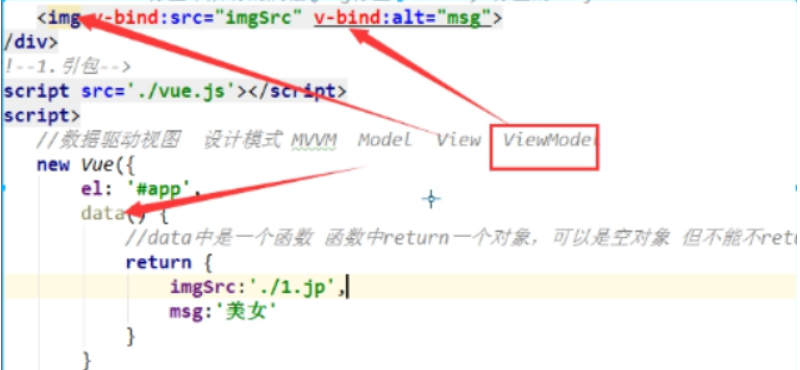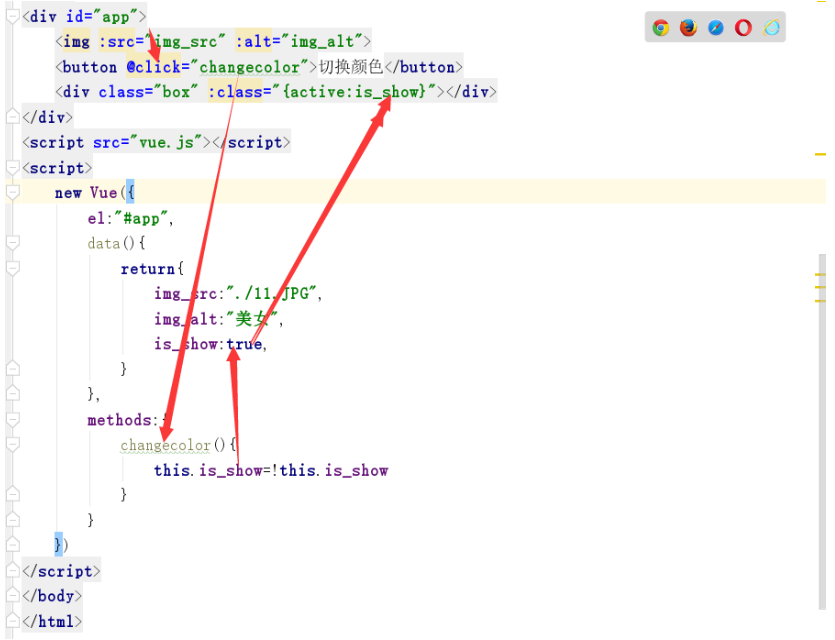es6基本语法,vue基本语法
一.es6基本语法
0.es6参考网站
http://es6.ruanyifeng.com/#README
1.let 和 const
(1)const特点:
只在局部作用域起作用
不存在变量提升
不能重复声明
Var声明变量提升问题:
<script>
//相当于在开头var a,所以第一次打印是undefined而不是报错
console.log(a); //undefined
{
var a=1;
console.log(a) //1
}
console.log(a) //1 </script>
变量重复声明问题:
<script>
{
var a=1;
var a=2;
console.log(a) //2 var可以重复声明,下一次会把上一次的覆盖
let b=1;
let b=2;
console.log(b) //Identifier 'b' has already been declared
//let不可以重复声明变量
}
</script>
(2)Let特点:
局部作用域
不能重复声明
只声明常量,不可变的量
2.模板字符串:用$和{}实现字符串的拼接
<script>
let name="shy";
let a=`我的名字叫${name}`;
console.log(a); //我的名字叫shy
</script>
3.箭头函数
语法:
<script>
let add1 = function add(x) {
return x
};
ret1=add1(10);//10
console.log(ret1);//以上为普通函数 let add2 = (x) => {
return x
};
ret2=add2(20);//20
console.log(ret2)//箭头函数的语法
</script>
简便写法:
<script>
let add3 =x =>x;
ret3=add3(30);
console.log(ret3)
</script>
4.es6的类
(1)使用匿名函数做方法的类
<script>
let person={
name:"shy",
age:13,
favorite:function(){
console.log(this.name)
}
};
person.favorite()//shy
</script>
(2)使用箭头函数做方法的类
<script>
let person={
name:"shy",
age:13,
favorite: () => {
console.log(111)
}
};
person.favorite()//11
</script>
(3)this的指向问题
<script>
//正常函数
let person1={
name:"shy",
age:13,
favorite:function (){
console.log(this)//{name: "shy", age: 13, favorite: ƒ}
}
};
person1.favorite();
//箭头函数
let person2={
name:"shy",
age:13,
favorite: () => {
console.log(this)//Window {postMessage: ƒ, close: ƒ, frames: Window, …}
}
};
person2.favorite()
</script>
总结:在普通的函数中,this是指向调用者,在箭头函数中this指向调用者的父类,即上下文
5.对象的单体模式
<script>
let person={
name:"shy",
fav(){
console.log(this)
}
//相当于以下写法
// fav:function(){
// console.log(this)
// }
}
</script>
相当于正常的函数,所以this的指向是调用者
6.基于原型给函数声明方法(函数的原型)
<script>
function Person (name,age){
this.name=name;
this.age=age;
}
Person.prototype.showname=function(){
console.log(this.name)
};
let person=new Person("shy",13);
person.showname()
</script>
注:给Person的原型添加一个 方法,以后其他地方也可以调用该方法,可以将prototype理解成Person的父类
7.类
<script>
class Person{
constructor(name,age){//放置参数
this.name=name;//这里的this与python中的self类似
this.age=age;
}
showname(){
console.log(this.name)
}
}
let person=new Person("shy",15);
person.showname()//shy
</script>
二. vue基本用法
1.介绍
Vue是一套用于构建用户界面的渐进式框架。创始人:尤雨溪
前端三大框架:
vue,
angular:谷歌公司
react:Facebook
2.下载,引用
(1)下载
在官网中;https://cn.vuejs.org/v2/guide/连接cdn的资源或下载使用均可
(2)引用,实例化
<body>
//模板语法
<div class="box">{{ message }}</div>
//引包
<script src="vue.js"></script>
<script>
//实例化对象
var box = new Vue({
//绑定元素
el: '.box',
//数据
data: {
message: 'Hello Vue!'
}
})
</script>
</body>
注:模板语法中可以放很多种类型的数据
<h2>{{ msg }}</h2> //字符串
<h3>{{ 'hhahda' }}</h3> //直接渲染字符串
<h3>{{ 1+1 }}</h3> //运算
<h4>{{ {'name':'alex'} }}</h4> //字典
<h5>{{ person.name }}</h5> //字典的使用
<h2>{{ 1>2? '真的': '假的' }}</h2> //三元运算符
<p>{{ msg2.split('').reverse().join('') }}</p>
<div>{{ <h2>日天</h2> }}</div> //标签
3.v-text,v-html
v-text相当于innertext,v-html相当于innerHTML
<body>
<div class="box">
<div v-text="msg"></div> //<h2>shy</h2>
<div v-html="msg"></div> //shy
</div>
<script src="vue.js"></script>
<script>
new Vue({
el:".box",
data(){
return{
msg:"<h2>shy</h2>"
//******
//data中必须是一个函数,函数中要return一个对象,可以是空对象
//******
}
}
})
</script>
</body>
4.v-if,v-show
<head>
<meta charset="UTF-8">
<title>Title</title>
<style>
.show_or_hide1{
height: 200px;
width: 200px;
background-color: #ce8483;
}
.show_or_hide2{
height: 200px;
width: 200px;
background-color: #ce412f;
}
</style>
</head>
<body>
<div class="box">
<button v-on:click="handlerclick">显示隐藏</button>
<div class="show_or_hide1" v-show="show_or_hide"></div>//v-show语法
<div class="show_or_hide2" v-if="show_or_hide"></div>//v-if语法
</div>
<script src="vue.js"></script>
<script>
new Vue({
el:".box",
data(){
return{
show_or_hide:true
}
},
methods:{
handlerclick(){
this.show_or_hide=!this.show_or_hide;
}
}
})
</script>
</body>
当show_or_hide为真时,盒子显示,show_or_hide为false时,盒子隐藏,V-show:相当于style.display,v-if相当于删掉盒子(渲染开销大),盒子消失时会用<!---->占位
v-show与v-if的区别
v-if vs v-show
v-if 是“真正”的条件渲染,因为它会确保在切换过程中条件块内的事件监听器和子组件适当地被销毁和重建。 v-if 也是惰性的:如果在初始渲染时条件为假,则什么也不做——直到条件第一次变为真时,才会开始渲染条件块。 相比之下,v-show 就简单得多——不管初始条件是什么,元素总是会被渲染,并且只是简单地基于 CSS 进行切换。 一般来说,v-if 有更高的切换开销,而 v-show 有更高的初始渲染开销。因此,如果需要非常频繁地切换,则使用 v-show 较好;如果在运行时条件很少改变,则使用 v-if 较好。
v-if可以与v-else一起使用
<body>
<div class="box">
<div v-if="Math.random() > 0.5">大于0.5</div>
<div v-else>小于0.5</div>
</div>
<script src="vue.js"></script>
<script>
new Vue({
el:".box",
data(){
return{ }
}
})
</script>
</body>
注:自定义属性和vue定义的属性在前端显示时,vue定 义的属性前会加一个$
5.v-bind和v-on
(1)v-bind
作用:用来绑定属性,如img标签的src,alt,a标签的href,id,class
语法:
<body>
<div id="app">
//绑定语法
<img v-bind:src="img_src" v-bind:alt="img_alt">
</div>
<script src="vue.js"></script>
<script>
new Vue({
el:"#app",
data(){
return{
img_src:"./11.JPG",
img_alt:"美女",
}
},
})
</script>
</body>
数据驱动视图,设计模式mvvm model view viewmodel


(2)v-on
作用:v-on可以监听所有的事件
例:动态添加active类名
<head>
<meta charset="UTF-8">
<title>Title</title>
<style>
.box{
width: 200px;
height: 200px;
background-color: #ce8483;
}
.active{
width: 200px;
height: 200px;
background-color: #637ece;
}
</style>
</head>
<body>
<div id="app">
//v-on的语法
<button v-on:click="changecolor">切换颜色</button>
//v-bind的另一种用法
<div class="box" v-bind:class="{active:is_show}"></div>
</div>
<script src="vue.js"></script>
<script>
new Vue({
el:"#app",
data(){
return{
is_show:true,
}
},
//v-on声明的函数都在methods里
methods:{
changecolor(){
this.is_show=!this.is_show
}
}
})
</script>
</body>
(3)v-bind和v-on的简便写法
v-bind可以使用":"来代替
v-on可以使用"@"来代替
<head>
<meta charset="UTF-8">
<title>Title</title>
<style>
.box{
width: 200px;
height: 200px;
background-color: #ce8483;
}
.active{
width: 200px;
height: 200px;
background-color: #637ece;
}
</style>
</head>
<body>
<div id="app">
//v-bind可以使用":"来代替
<img :src="img_src" :alt="img_alt">
//v-on可以使用"@"来代替
<button @click="changecolor">切换颜色</button>
<div class="box" :class="{active:is_show}"></div>
</div>
<script src="vue.js"></script>
<script>
new Vue({
el:"#app",
data(){
return{
img_src:"./11.JPG",
img_alt:"美女",
is_show:true,
}
},
methods:{
changecolor(){
this.is_show=!this.is_show
}
}
})
</script>
</body>
数据驱动视图

声明式和命令式的区别
命令式编程:命令“机器”如何去做事情(how),这样不管你想要的是什么(what),它都会按照你的命令实
声明式编程:告诉“机器”你想要的是什么(what),让机器想出如何去做(how)。
5.v-for
<body >
<div id="app">
//只有在确认状态正常时,才显示该列表
<ul v-if="data.static=='ok'">
<li>id---姓名---年龄</li>
//v-for语法
//循环元素和索引,顺序是(元素,索引)
<li v-for="(item,index) in data.users " :key='item.id'>
//一定要绑定key,可以节省性能的消耗,有id绑定id,没有id绑定,不用Vue来计算dom,使用key表示来计算,以节省性能
{{ item.id }}---{{ item.name }}---{{ item.age }}
</li>
</ul>
</div> <script src="vue.js"></script>
<script>
new Vue({
//不能直接用body标签
el:"#app",
data(){
return{
//模拟后端返回数据
data:{
static:"ok",
users:[
{id:1,name:"shy",age:""},
{id:2,name:"jwb",age:""},
{id:3,name:"jwo",age:""},
]
}
}
},
})
</script>
</body>
v-for也可以便利对象
<body >
<div id="app">
<ul>
//此处的顺序一定是先value,后key
<li v-for="(value,key) in person">{{ key }}--{{ value }}</li>
</ul>
</div>
<script src="vue.js"></script>
<script>
new Vue({
el:"#app",
data(){
return{
person:{
name:"shy",
hobby:"sking"
},
}
},
})
</script>
</body>
三.实例
1.轮播图的实现
<body>
<div id="app">
<img :src="data:images[currentindex].imgsrc" alt="aaa"> <br>
<button @click="preHandler">上一张</button>
<button @click="nextHandler">下一张</button>
</div>
<script src="vue.js"></script>
<script>
let vm=new Vue({
el:"#app",
data(){
return{
images:[
{id:1,imgsrc:"./assets/1.png"},
{id:2,imgsrc:"./assets/2.png"},
{id:3,imgsrc:"./assets/3.png"},
{id:4,imgsrc:"./assets/4.png"},
],
currentindex:0
}
},
methods:{
preHandler(){
this.currentindex-=1;
if(this.currentindex==0){
this.currentindex=3
}
},
nextHandler(){
this.currentindex+=1;
if(this.currentindex==4){
this.currentindex=0
}
}
}
})
</script>
</body>
加定时器自动轮播的轮播图
<body>
<div id="app">
<img :src="data:images[currentindex].imgsrc" alt="aaa"> <br>
<button @click="preHandler">上一张</button>
<button @click="nextHandler">下一张</button>
</div>
<script src="vue.js"></script>
<script>
let vm=new Vue({
el:"#app",
data(){
return{
images:[
{id:1,imgsrc:"./assets/1.png"},
{id:2,imgsrc:"./assets/2.png"},
{id:3,imgsrc:"./assets/3.png"},
{id:4,imgsrc:"./assets/4.png"},
],
currentindex:0
}
},
methods:{
preHandler(){
this.currentindex-=1;
if(this.currentindex==0){
this.currentindex=3
}
},
nextHandler(){
this.currentindex+=1;
if(this.currentindex==4){
this.currentindex=0
}
}, },
//created方法DOM创建完成时执行的方法
created(){
//定时器
setInterval(() => {
//使用箭头函数,使this指向vue,如果不用箭头函数,则指向window对象
console.log(this);
this.currentindex+=1;
if (this.currentindex == 4) {
this.currentindex = 0;
}
}, 2500);
}
})
</script>
</body>
2.vue中使用ajax
(1)从后端接口获取数据
<body>
<div id="app"> <span v-for="a in names" :key="a.id">{{ a.name }} </span> </div>
<script src="vue.js"></script>
<script>
new Vue({
el:"#app",
data(){
return{names:[]}
},
created(){
$.ajax({
url:"https://www.luffycity.com/api/v1/course_sub/category/list/",
type:"get",
success:(response) => {
console.log(response);
//push是往数组的最后添加一项,unshift是向数组的开头添加一项,shift是从数组的开头删除一项
response.data.unshift({"id":0,"name":"全部","category":10})
this.names=response.data;
//如果不用箭头函数,this指向ajax
console.log(this);
console.log(response.data);
}
})
}
})
</script>
</body>

(2)点击颜色渲染
<head>
<meta charset="UTF-8">
<title>Title</title>
<script src="./js/jquery.js/"></script>
<style>
.active{
color: #1cb7fd;
}
</style>
</head>
<body>
<div id="app">
//v-on监听事件时,可以对事件传参数
<span @click="change_color(index)" :class="{active:index==currentindex}" v-for="(a,index) in names" :key="a.id">{{ a.name }} </span>
</div>
<script src="vue.js"></script>
<script>
new Vue({
el:"#app",
data(){
return{names:[],currentindex:0}
},
created(){
$.ajax({
url:"https://www.luffycity.com/api/v1/course_sub/category/list/",
type:"get",
success:(response) => {
console.log(response);
//push是往数组的最后添加一项,unshift是向数组的开头添加一项,shift是从数组的开头删除一项
response.data.unshift({"id":0,"name":"全部","category":10})
this.names=response.data;
//如果不用箭头函数,this指向ajax
console.log(this);
console.log(response.data);
}
})
},
methods:{
change_color(index){
this.currentindex=index
}
}
})
</script>
</body>

3.音乐播放器
<head>
<meta charset="UTF-8">
<title>Title</title>
<style>
//正在播放的音乐背景颜色加深类名
.active{
background-color: #ce8483;
}
</style>
</head>
<body>
<div id="music">
<!--//controls autoplay显示播放按钮等-->
//ended方法:当前歌曲执行完毕后执行
<audio :src="musicData[currentIndex].songSrc" controls autoplay @ended="next"></audio>
<ul>
<li @click="songHandler(index)" v-for="(item,index) in musicData" :key="item.id" :class="{active:index==currentIndex}">
<h2>歌名:{{ item.name }}</h2>
<h3>歌手:{{ item.author }}</h3> <br>
</li>
</ul>
</div>
<script src="vue.js"></script>
<script>
var musicData = [{
id: 1,
name: '于荣光 - 少林英雄',
author: '于荣光',
songSrc: './static/于荣光 - 少林英雄.mp3'
},
{
id: 2,
name: 'Joel Adams - Please Dont Go',
author: 'Joel Adams',
songSrc: './static/Joel Adams - Please Dont Go.mp3'
},
{
id: 3,
name: 'MKJ - Time',
author: 'MKJ',
songSrc: './static/MKJ - Time.mp3'
},
{
id: 4,
name: 'Russ - Psycho (Pt. 2)',
author: 'Russ',
songSrc: './static/Russ - Psycho (Pt. 2).mp3'
}
];
new Vue({
el:"#music",
data(){
return{
musicData:[],
currentIndex:0
}
},
created(){
this.musicData=musicData
},
methods:{
//点击li标签播放歌曲
songHandler(index){
console.log(111);
this.currentIndex=index
},
next(){
this.currentIndex++
}
}
})
</script>
</body>
4.计算属性和侦听器
(1)侦听器watch
<body>
<div id="app">
<p>{{ message }}</p>
<button @click="message='dsz'">更换</button>
</div>
<script src="vue.js"></script>
<script>
new Vue({
el:"#app",
data(){
return{
message:"shy",
aaa:"aaa"
}
},
//watch监听器可以监听多个属性
watch:{
"message":function(a){
//此时的a是改变后的message
console.log(a);
//此处可以对message的值进行操作
this.message="shy"
},
"aaa":function(a){
console.log(a);
}
}
})
</script>
</body>
(2)计算属性computed
<body>
<div id="app">
<p>{{ msg }}</p>
<button @click="name='dsz'">更换</button>
</div>
<script src="vue.js"></script>
<script>
new Vue({
el:"#app",
data(){
return{
name:"shy",
age:18
}
},
//计算属性语法
//计算属性可以监听多个"多个属性"或'单个属性'
computed:{
//计算属性默认值有getter方法
msg:function(){
return `我是${ this.name },今年${ this.age }`
}
}
})
</script>
</body>
es6基本语法,vue基本语法的更多相关文章
- python 全栈开发,Day89(sorted面试题,Pycharm配置支持vue语法,Vue基础语法,小清单练习)
一.sorted面试题 面试题: [11, 33, 4, 2, 11, 4, 9, 2] 去重并保持原来的顺序 答案1: list1 = [11, 33, 4, 2, 11, 4, 9, 2] ret ...
- Vue常用语法及命令
1,Vue常用语法 vue常用语法之变量的定义 // 1,变量相关 // 变量的提升 var username = "雪雪"; var username ; console.log ...
- 如何在webpack开发中利用vue框架使用ES6中提供的新语法
在webpack中开发,会遇到一大推问题,特别是babel6升级到babel7,要跟新一大推插件,而对于安装babel的功能就是在webpack开发中,vue中能够是用ES6的新特性: 例如ES6中的 ...
- 一、vue基础--语法
用到的前台编程工具是Visual Studio Code,暂时是官网下载vue.js到本地使用 一.Visual Studio Code需要安装的插件: jshint :js代码规范检查 Beau ...
- ES6的介绍和常用语法
本文最初发表于博客园,并在GitHub上持续更新前端的系列文章.欢迎在GitHub上关注我,一起入门和进阶前端. 以下是正文. 前言 ECMAScript 是 JS 的语言标准.而 ES6 是新的 J ...
- idea 添加 VUE 的语法支持和开发
<一>VUE的开发分两种,一种是直接在HTML文件中使用,一种是VUE文件的形式开发 1,首先我们先让 HTML 文件支持 VUE 的语法指令提示 2,File -> Setting ...
- 2-5 vue基础语法
一.vue基础语法 语法: {{msg}} html赋值: v-html="" 绑定属性: v-bind:id="" 使用表达式: {{ok? "ye ...
- Vue 数据绑定语法
数据绑定语法 Vue.js 的模板是基于 DOM 实现的.这意味着所有的 Vue.js 模板都是可解析的有效的 HTML,且通过一些特殊的特性做了增强.Vue 模板因而从根本上不同于基于字符串的模板, ...
- 2. Vue基础语法
模板语法: Mustache语法: {{}} Html赋值: v-html="" 绑定属性: v-bind:id="" 使用表达式: {{ok?'Yes': ...
随机推荐
- 64 位系统 vs2013 配置 OpenCV-3.1.0
参考:64 位系统 vs2013 配置 opencv3.0 1. 环境准备 进入官网 http://opencv.org/,下载最新版本的 opencv(以本文 opencv-3.1.0 为例,.ex ...
- Android官方教程翻译(6)——添加ActionBar
The action bar allows you to add buttons for the most important action items relating to the app's c ...
- Android Gallery组件实现循环显示图像
Gallery组件主要用于横向显示图像列表,只是按常规做法.Gallery组件仅仅能有限地显示指定的图像.也就是说,假设为Gallery组件指定了10张图像,那么当Gallery组件显示到第10张时, ...
- URAL 1684. Jack's Last Word KMP
题目来源:URAL 1684. Jack's Last Word 题意:输入a b 把b分成若干段 每一段都是a的前缀 思路:b为主串 然后用a匹配b 记录到b的i位置最大匹配的长度 然后切割 切割的 ...
- IP packet transmission using vehicular transport
In one embodiment, a first stationary router may detect a disconnected backhaul link to a destinatio ...
- [Spring Boot 系列] 集成maven和Spring boot的profile 专题
maven中配置profile节点: <project> .... <profiles> <profile> <!-- 生产环境 --> <id& ...
- silverlight,WPF动画终极攻略之迟来的第三章 动画整合篇(Blend 4开发)
原文:silverlight,WPF动画终极攻略之迟来的第三章 动画整合篇(Blend 4开发) 有个问题想请教下大家,我仿了腾讯的SL版QQ,相似度95%以上.我想写成教程教大家怎么开发出来,会不会 ...
- arcserver开发小结(一)
一.关于属性查询 由于要做属性查询,又重新玩起了arcmap中的select by attribute,有很多自己当初玩弄arcmap多年还不是很清楚的东西 1,字段名 (1)file geodata ...
- Robot Framework 快速入门_中文版
目录 介绍 概述 安装 运行demo 介绍样例应用程序 测试用例 第一个测试用例 高级别测试用例 数据驱动测试用例 关键词keywords 内置关键词 库关键词 用户定义关键词 变量 定义变量 使用变 ...
- OpenGL(六) gluLookAt和gluPerspective函数解析
在调用gluLookAt和gluPerspective函数之前一般要先调用一下glLoadIdentity函数,先说一下这个函数是做什么的. glLoadIdentity glLoadIdentity ...
